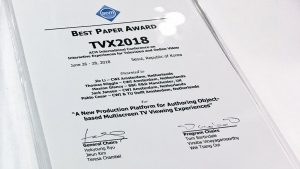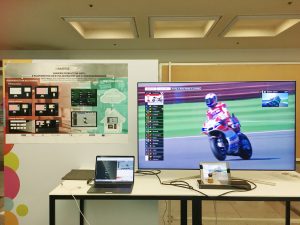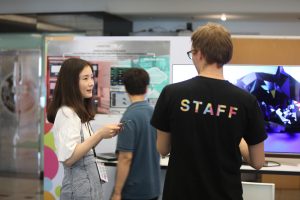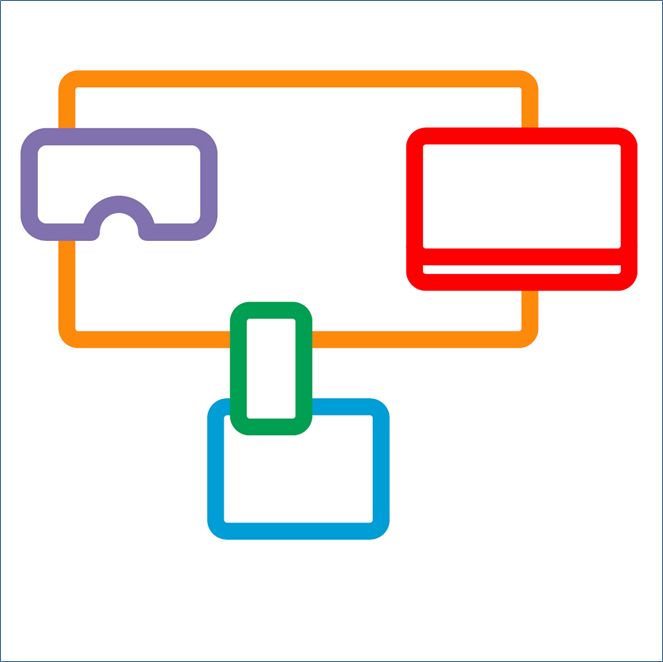Object-based media: the ‘next big thing’
“BT Sport: Object-based delivery ‘next big thing’ ” – so reads the title of a recent article on the web site Advanced Television. Doug Williams from BT argues that this illustrates that we are making progress on exploitation – although perhaps not in the way you might expect.
A key objective of an Innovation action like 2-IMMERSE is to be able to show that the project has an impact, and most particularly that it leads to commercial impact. Simplistically it would be nice to think 2-IMMERSE designed and proved the viability of a widget, and that following the project a new company was started that made, marketed and sold said widget. That would be an easy story to tell – but things don’t often work like that.
2-IMMERSE is a collaborative project involving, among others, BBC, BT, CISCO and IRT, and in this blog post I want to tell you a little about some of the progress we are making towards delivering our exploitation objectives. I am not telling the whole story, just relating something of what is happening in BT.
 As in the suggested ‘easy to tell’ story, 2-IMMERSE is designing and proving the viability of something, though that something is not a widget. We are proving, through the work done on the MotoGP experience and on the football trials, for example, that using the object–based delivery approach, we can create multi screen TV-based experiences and that those experiences can be appealing. We have worked closely with rights holders BT Sport and Dorna Sports as our experiments progressed and we have shared our progress with those rights holders along the way.
As in the suggested ‘easy to tell’ story, 2-IMMERSE is designing and proving the viability of something, though that something is not a widget. We are proving, through the work done on the MotoGP experience and on the football trials, for example, that using the object–based delivery approach, we can create multi screen TV-based experiences and that those experiences can be appealing. We have worked closely with rights holders BT Sport and Dorna Sports as our experiments progressed and we have shared our progress with those rights holders along the way.
A fundamental aspect of this project is that the delivery of the TV experiences is based on objects – where those objects can be video streams, graphics, audio streams or interactive elements that are assembled, according to rules, across the devices that are available to present the experience. There might be an element of “so what?” to that description. It does not highlight any benefits and gives no obvious reason why such an approach is useful to a broadcaster. But there is a simple benefit addressing something that is distinctly missing from current TV services — and that is the ability to personalise or customise the experience to better suit the context in which the TV experience is being consumed.
TV is great. I am writing this the morning after nearly half the UK population were together watching England play, and disappointingly lose, in the semi-final of the World Cup. Television is the only medium than can achieve such moments where such a large fraction of the population are all sharing the same experience. And that’s magic.
But.
• What if I was hard of hearing and wanted to quieten that crowd volume and increase the commentary volume so I could hear the commentary more clearly? I couldn’t do that last night, but I could with the object-based delivery approach.
• What if I was watching on a small TV and found the graphics a bit hard to read and wanted to increase the size of the graphics so I could read them more easily? I couldn’t do that last night, but I could do that with the object-based delivery approach.
• What if I was profoundly deaf and wanted to pull up a signed commentary on the TV screen? I couldn’t do that last night, but with the object-based delivery approach that is possible.
• What if I wanted to actively track the relative possession enjoyed by each of the teams throughout the game? I couldn’t do that last night, but I could do so with the object-based delivery approach.
• What if I was interested in seeing at all times, the expressions on each of the different managers’ faces? I couldn’t do that last night, but with the object-based delivery approach I could.
The object-based delivery approach provides ithe ability to personalise the TV experience to better address the needs of a large number of niche populations. Whether they are characterised by a need for more data, clearer graphics or a different audio mix. We’ve been discussing these options with our rights-holders partners for some time now, and together we are beginning to focus on these benefits and to work out how we could take them from the lab to the living room.
BT Sport have a fantastic innovation record. BT Sport were the first to do deliver live UHD TV in Europe. BT Sport were among the first to provide 360 video coverage of live sporting events. BT Sport were the first to use Dolby Atmos to deliver even more compelling soundscape to accompany the pictures. And now? Well now it’s good to see reports of Jamie Hindhaugh, COO of BT Sport, and the one who has driven innovation in the company, ruminating on what innovations are next in the pipeline.
have a fantastic innovation record. BT Sport were the first to do deliver live UHD TV in Europe. BT Sport were among the first to provide 360 video coverage of live sporting events. BT Sport were the first to use Dolby Atmos to deliver even more compelling soundscape to accompany the pictures. And now? Well now it’s good to see reports of Jamie Hindhaugh, COO of BT Sport, and the one who has driven innovation in the company, ruminating on what innovations are next in the pipeline.
According to an article penned by Colin Mann of the Advanced Television web site, reporting on the Love Broadcasting Summit,
[Jamie Hindhaugh] didn’t see VR and 3D as necessarily the future for sports viewing, as they lacked the social aspect, with BT preferring to offer such options as different camera angles, instead suggesting that object-based delivery would grow with the spread of IP. ‘We will start giving you objects, packages, templates, so you can create your own version of what you are watching.‘
Hindhaugh said that hardcore fans of MotoGP could benefit from additional graphics and stats available to the broadcaster. BT would curate the data, and allow the viewer to choose their preferences from the programme feed. ‘That’s where we’re going. That’s where the next big initiative is coming through, combined with 5G mobile.’
We have always seen our greatest potential for innovation impact in large companies as being the ability to affect the way they choose to develop their services. We have set out to work with the parts of our business that run key services and to effect innovative change. We are pleased to see the ideas we are developing and demonstrating are appealing not only to users but also to decision makers and that innovations developed in this project could be the ‘next big thing’.
READ MORESuccess for 2-Immerse at TVX
Jie Li honoured with Best Paper Award
 On 27 June Jie Li of the Distributed and Interactive Systems (DIS) group at 2-IMMERSE partner CWI was awarded with the Best Paper Award at ACM TVX 2018, the ACM International Conference on Interactive Experiences for Television and Online Video. Li won the award for the paper ‘A New Production Platform for Authoring Object-based Multiscreen TV Viewing Experiences’. Outlining research done within 2-IMMERSE, the paper has as co-authors Pablo Cesar, Maxine Glancy (BBC), Jack Jansen and Thomas Röggla
On 27 June Jie Li of the Distributed and Interactive Systems (DIS) group at 2-IMMERSE partner CWI was awarded with the Best Paper Award at ACM TVX 2018, the ACM International Conference on Interactive Experiences for Television and Online Video. Li won the award for the paper ‘A New Production Platform for Authoring Object-based Multiscreen TV Viewing Experiences’. Outlining research done within 2-IMMERSE, the paper has as co-authors Pablo Cesar, Maxine Glancy (BBC), Jack Jansen and Thomas Röggla

Multiscreen TV viewing refers to a spectrum of media productions that can be watched on TV screens and companion screens such as smartphones and tablets. TV production companies are now promoting an interactive and engaging way of viewing TV by offering tailored applications for TV programs.
However, viewers are demotivated to install dozens of applications and switch between them. This is one of the obstacles that hinder companion screen applications from reaching mass audiences. To solve this, TV production companies need a standard process for producing multiscreen content, allowing viewers to follow all kinds of programs in one single application. This paper proposes a new object-based production platform for authoring and broadcasting programs for multiscreen.
 Besides the awarded paper, the DIS group also presented a demo at the conference, showcasing object-based live broadcasting of a sports event, to both a large TV screen and companion screens. The demo included both the producer and the user side. The producer side takes place inside an outside broadcast truck, where the director/producer can insert on-demand snippets and interactive components in the live broadcast. The user side is a home, where a viewer with a TV screen and several companion devices enjoy a personalized and interactive experience.
Besides the awarded paper, the DIS group also presented a demo at the conference, showcasing object-based live broadcasting of a sports event, to both a large TV screen and companion screens. The demo included both the producer and the user side. The producer side takes place inside an outside broadcast truck, where the director/producer can insert on-demand snippets and interactive components in the live broadcast. The user side is a home, where a viewer with a TV screen and several companion devices enjoy a personalized and interactive experience.

CWI’s Distributed and Interactive Systems (DIS) research group focuses on facilitating and improving the way people access media and communicate with others and with the environment. They address key problems for society and science, resulting from the dense connectivity of content, people, and devices. The group uses recognized scientific methods, following a full-stack, experimental, and human-centered approach.
More at TVX from BBC and IRT
A work-in-progress paper submitted by BBC and IRT explores the potential of augmented reality technology as a novel way to allow users to view a sign language interpreter through an optical head-mounted display while watching a TV programme. We address the potential of augmented reality for personalisation of TV access services. Based on guidelines of regulatory authorities and research on traditional sign language services on TV, as well as feedback from experts, we justify two design proposals. We describe how we produced the content for the AR prototype applications and what we have learned during the process. Finally, we develop questions for our upcoming user studies.
Also at TVX BBC and IRT demonstrated results of our work stream which targets deploying the 2-IMMERSE apps on HbbTV 2.0 devices. In cooperation with Samsung we showed the 2-IMMERSE MotoGP experience from Silverstone GP 2017 on a recent consumer device running an HbbTV 2.0 ready firmware.
READ MOREMotoGP roars out on a HbbTV 2 television
MICHAEL PROBST from the 2-IMMERSE partner IRT introduces an impressive video showcasing our MotoGP prototype running on a HbbTV 2 television.
The 2-IMMERSE architecture has been built around the HbbTV 2 specification, mainly using the new protocols defined for interaction and media synchronisation with multiple screens in the home network.
During the services trials, the project has made use of custom prototype units as client devices. For the most recent trials a Intel NUC-based Linux PC was used to emulate the main TV and feed the screen in the home.
In a parallel track, however, the 2-IMMERSE implementation of the MotoGP trial has been tested and validated with televisions supporting HbbTV2 that became available in 2018. Watch the video, hosted by IRT’s Florian Bachmann, to see the MotoGP showcase on one of the first HbbTV 2 televisions and learn more about which features 2-IMMERSE actually uses from HbbTV 2.
You can see this demonstration at IFA in Berlin (31 August – 5 September) and IBC2018 in Amsterdam (14-18 September) at the IRT stands (hall 2.2@IFA, 10F51@IBC) in addition to the 2-IMMERSE main presentation in the IBC Future Zone.
READ MOREMotoGP – “nearly there”
DOUG WILLIAMS from BT R&D reports on our first user testing for the 2-IMMERSE MotoGP prototype:
Back in November 2017 we started evaluation of our MotoGP service prototype with people (real, ordinary people!) who were using it in their own home. The MotoGP service prototype is a multi-screen experience delivered via our cloud based micro-service infrastructure. The key group whose opinion we sought was people who already watch MotoGP on TV, and we wanted their feedback about our new multi-screen experience. (If you’re not familiar with our MotoGP experience you can see our video of it here.)
The results from the first 85 respondents are in and we are beginning to get to grips with the mountain of data and comments. We are, our users tell us, nearly there.
We asked our users to assess the value of the features we provide on a scale of 1-10 (where 10 is good). The details of all the features are described here.
Overall, the results are very encouraging. We sought evaluations of the different features we offered and for each participant to comment on their ease of use. As can be seen in the graphic below, scores approached 9/10 for all features – from which we have to conclude that we have done something right.

No, not everything was perfect. Some users experienced absolute failures (it is a prototype); some found the joining process a little tricky:
getting the sequencing right connecting the right thing to the right WiFi at the right time was a bit of a faff.
Some thought the responsiveness could be better, and some wanted an ‘undo’ capability. Also when asked about the level of control users had in our prototype, 88% said they wanted more control over how the video and graphics were laid out across all the screens.
The prototype, our users told us, was not perfect. Certain features that we were really keen on, such as the ability to adjust the graphics size so they better suit the size of your TV, and the ability to change the way the leaderboard was presented were, in terms of perceived value, ranked towards the bottom of the 8 broad features we assessed.
Overall, however, 9 out of 10 for all features is feels very positive. And feedback like this is very encouraging:
I would just say it’s worth getting. Really good for MotoGP… this is the future of TV… [I] don’t expect to watch [MotoGP] the same way again.
User feedback in projects like this is essential, but it is not the whole story. Feedback from the production industry is also critical – and that’s why we recently took the MotoGP to NAB. See this post to read about what industry insiders thought.
READ MOREPresenting to the presenter
DOUG WILLIAMS from BT R&D writes: Do take a look at this video from June 2017, taken during an Innovation Event at BT’s global research headquarters at Adastral Park in the UK. At this event BT shares its research, both internal and collaborative, with customers, the press, investors and colleagues.
We had the opportunity to demonstrate our stand-alone prototype of the MotoGP at home service. This prototype did not use the “proper” 2-IMMERSE infrastructure but the demo was good enough to allow us to share ideas with key influencers across the business. Their feedback, and our own assessment of how features actually appeared, helped us identify features we thought were most important. Responsive design and dynamic control, from a tablet, of a 360 bike-cam as a picture in picture on the main screen were the favourites.
It also gave us the chance to share our work with some of those who present BT Sport. In the video Andy Gower talks to Craig Doyle, one BT Sport’s main presenters.
Of course the service prototype we have built for evaluation is much more feature complete, as you can see from the summary video of the MotoGP experience but this early stand-alone demo allowed Andy to develop and test design ideas more quickly.
READ MOREMotoGP at Home – the video
We are pleased to announce that we have made a short video of our MotoGP at Home Experience. You can find it on our videos page. https://2immerse.eu/videos/
The MotoGP experience is now (January 2018) in test. We are taking our 8 test kits out to users, and they are trying it out. Users have been screened on the basis that they are MotoGP fans (not everyone is) and watch it on TV. We had a small hiatus during Christmas (this gave us chance to upgrade the software on the machines too!) but with the Christmas decoration tidied away we are back out testing again. To date we have had 35 responses and by 25 January we should be pushing 90 responses. Our target is 100 responses.
What we want to know is, do our users prefer the multi-screen experience to the single screen experience?
The whole thing takes about 90 minutes, during which time users can explore the additional information and features that can be accessed and controlled on the companion screens. The questionnaire they complete after the trial probes their overall reaction to the experience before going deeper into their spontaneous recall of features (what do they remember it by?) and then probing their use, and perception of, the feature set on offer.
The MotoGP experience needs a specific small computer to act as set top box, as I wrote earlier https://2immerse.eu/its-trial-time/ . Because of this not many of you will get to play with it directly. The next best thing, in terms of communicating what this experience includes, is the video.
The trials are being conducted independently from the project by Acumen Fieldwork http://www.acumenfieldwork.com
We look forward to receiving a full set of results in due course and to comparing the questionnaire responses with the logs we collect from the servers. What features were used most? Were any features not used? These are all questions we hope the logs will tell us.
And, as the video expresses, our thanks are due to Dorna Sports, BT Sport and North One Television for their support during the development of the MotoGP 2-IMMERSE project.
READ MOREIt’s trial time!
DOUG WILLIAMS from BT writes: Will the system work? We are in the final throes of preparing for the MotoGP at Home trial, as the boxed up “kits” above demonstrate. Anyone who has been in that state will be familiar with the uneasy mix of excitement and uncertainty.
For the MotoGP at home tests we are seeking an evaluation, from MotoGP fans, of our ‘as-live’ multi-screen production of this year’s Silverstone race. We are conducting nearly all the trials in people’s homes and our ambition is that the system is robust enough and simple enough for our triallists to use with minimal instruction; we are seeking 100 responses.
At the moment the experience depends on support for elements of the HbbTV2.0 specification and some other capabilities that cannot be reliably found on any common TV platform. So we are having to provide a small computer together with a phone and tablet as the apps we are using are not available on any app store. That’s what you can see in front of the boxes.
There is a lot of last minute logistics and bug-fixing going on and Murphy’s law is in full operation. To help on the logistics side – needing to find 50 duo households of people who are already keen on MotoGP – we have enlisted the help of a recruiting agency, Acumen, who will tomorrow receive seven test kits and some training from us and who will then go away and start conducting tests with screened triallists who already watch MotoGP.
Fundamentally we want to know whether the experience we create feels like an enhancement to the excellent coverage already available. We want the evaluation to uncover more about the utility, and perhaps futility, of certain features, and so help us to retain good ideas and drop bad ones. And we intend too that it will help us highlight the strengths and weaknesses of the technical platform on which it is all built.
We trust our triallists enjoy their experience — and of course we hope the system works!
READ MORE

